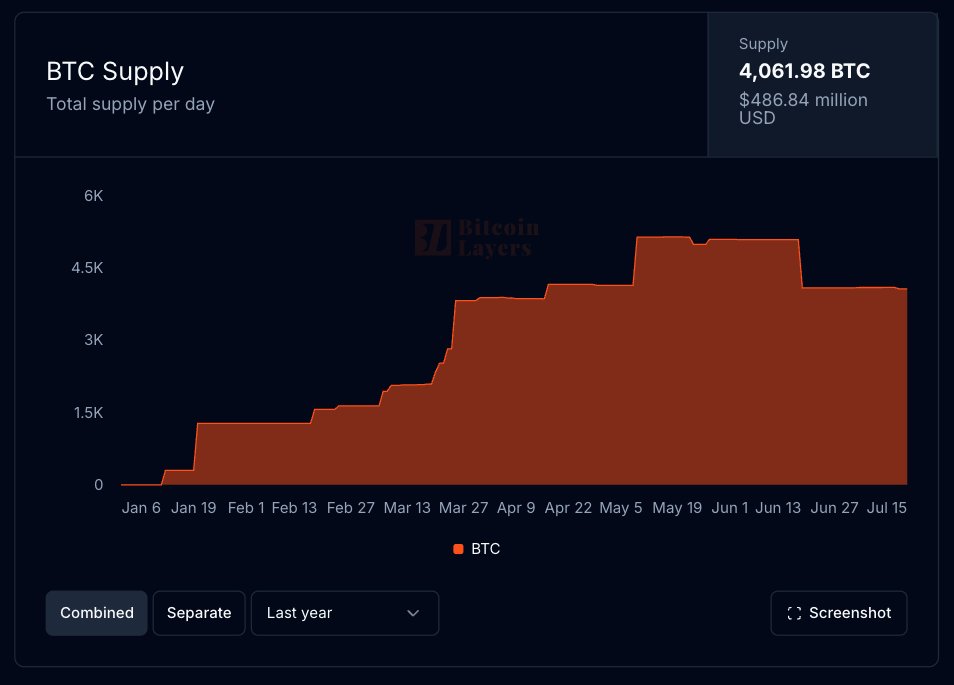Finished a full review on @hemi_xyz. Summary below & full review threaded 👇
Hemi has 4,061~ BTC-backed tokens minted on its network. Users face some key trust assumptions here:
Main trust assumptions
In my opinion, the main trust assumptions with Hemi are:
- BTC-backed tokens on the network are secured by centralized custodians/entities.
- An alternative data availability is responsible for making the data available. Users trust Ethereum full nodes to make the data available to advance Hemi’s state
- A centralized sequencer can have liveness failures or censor users
- A centralized proposer can submit a malicious state and drain the bridge escrowing wBTC and tBTC
- Key systems and bridge escrow contracts are immediately upgradable by a ⅜ multisig
Design tl;dr
Hemi is an Ethereum rollup built on the OP stack.
It has a centralized sequencer that is responsible for ordering Hemi’s transactions into blocks. Periodically the sequencer submits blobs of data, containing Hemi blocks, to Ethereum. After this, Hemi full nodes update the state. After the state is updated, a centralized proposer submits a state root to a bridge program on Ethereum.
Hemi also employs a validator set in what it calls “proof-of-proof consensus”. After the latest state root is generated, this validator set races to submit the state root to bitcoin. This “anchors” Hemi’s state to bitcoin.
Hemi has two official bridge programs. They call these “tunnels”. One is a (what I believe) a centralized bridge program securing BTC backing HemiBTC, a bitcoin-backed ERC-20 asset on Hemi. There is no documentation on who the signers are, or what threshold signature scheme this bridge program may be leveraging.
It additionally escrows various bitcoin-backed assets in a standard Ethereum escrow contract. This contract is not secured by any proving system. As stated above, a malicious operator could drain this specific bridge program.
There are also a number of other wrapped bitcoin assets available on Hemi. These assets are ultimately secured by centralized custodians and have been bridged to the network through any given third party provider, not official bridge programs
Connection to bitcoin
Hemi is connected to bitcoin through its proof-of-proof validator set. After a validator posts a state root to bitcoin, Hemi network participants ultimately consider the state finalized.
But since its official bridge program does not (from our vantage point) have a public federation, it is considered an “integrated chain” and not a “sidesystem”.
What type of layer is it? My opinion
In my opinion, Hemi is a sovereign network that inherits security from Ethereum. Its Ethereum bridges do not inherit this security as there is no proving system and the bridge contracts are immediately upgradable. Its bitcoin-backed assets are ultimately secured by centralized custodians or federations.
I’m unsure of the security guarantees “bitcoin finality” gives you here. I believe the sequencer has an incentive to not reorg the state to continue earning fees and grow its user base.
Regardless, even if it does give you stronger finality guarantees, it wouldn’t change my opinion on what type of network it is:
A sovereign network that inherits security from Ethereum and additionally anchors its state to bitcoin.
Additional context
Unlike its testnet, I couldn’t find any dashboards showing activity related to proof-of-proof validators submitting state updates to bitcoin.

5.11K
2
The content on this page is provided by third parties. Unless otherwise stated, OKX TR is not the author of the cited article(s) and does not claim any copyright in the materials. The content is provided for informational purposes only and does not represent the views of OKX TR. It is not intended to be an endorsement of any kind and should not be considered investment advice or a solicitation to buy or sell digital assets. To the extent generative AI is utilized to provide summaries or other information, such AI generated content may be inaccurate or inconsistent. Please read the linked article for more details and information. OKX TR is not responsible for content hosted on third party sites. Digital asset holdings, including stablecoins and NFTs, involve a high degree of risk and can fluctuate greatly. You should carefully consider whether trading or holding digital assets is suitable for you in light of your financial condition.

